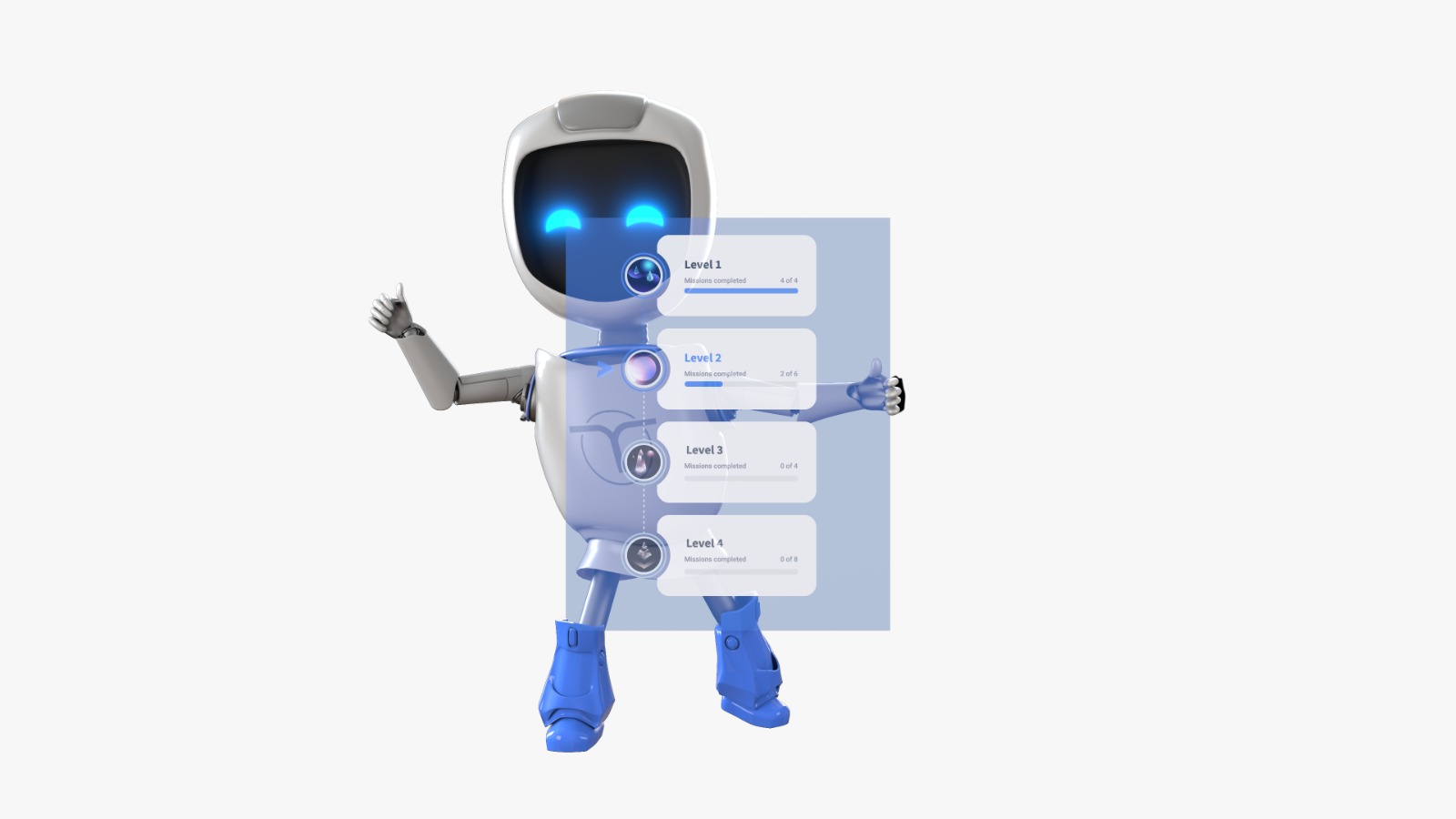The one question that lingers on everyone’s minds these days: will I lose my job because of AI? AI is expected to pump $19.9 trillion into the global economy, contributing 3.5% to the global GDP, both by 2030. McKinsey also projects that by 2030, around 70% of companies will have adopted at least one AI technology. In Learning and Development (L&D), we are just now starting to see the shift to AI instructional design, as more companies embrace AI into their training programs. For example, according to Traininmag’s 2024 report, around 46% of large companies used AI in their L&D efforts.
Still, despite the numbers and the fear and uncertainty that AI’s integration has sparked across the corporate world, we need to consider that L&D, at its core, is an industry deeply integrated in human interaction and input.
So, what does this mean for instructional designers, training coordinators, learning specialists, and facilitators? In this article, we’ll explore the key benefits and challenges of AI in instructional design, and offer actionable steps for L&D professionals to embrace and adapt to the fourth technological revolution.

Is AI Instructional Design Replacing Humans?
The short answer is no. AI isn’t replacing jobs, but it’s transforming them. This shift is similar to what happened when computers were introduced in the workplace in the ’80s and ’90s. Computers couldn’t function without human operators, and eventually, new roles like IT specialists emerged as a result.
For example, a report by the Tony Blair Institute noted that while AI may displace between 1 million and 3 million private sector jobs in the UK, this disruption is expected to be relatively modest, as new roles will replace those lost. The report also suggests that automation will displace between 60,000 and 275,000 jobs annually at its peak, which pales in comparison to the 450,000 job losses typically seen in the UK each year.
Task Automation: The Real Impact of AI in L&D
Many routine and administrative tasks traditionally handled by instructional designers, like formatting and content management, are already being automated. According to a Goldman Sachs report, 25% of routine tasks can already be robotized. On the other hand, tasks requiring emotional intelligence, strategic design, and context-building remain well within the human domain. This automation allows L&D professionals to focus on more strategic tasks, such as designing training programs that align with organizational goals.
In fact, many L&D departments are already re-skilling their staff to become proficient in AI-augmented learning initiatives. These professionals are tasked not just with creating content, but with teaching employees how to navigate and incorporate AI tools into their jobs, according to PwC.
As the workforce changes, it’s clear that instructional design is evolving, not disappearing.
Why AI Instructional Design Is a Game Changer for L&D
AI’s impact on our lives is no longer a subject of novelty. In L&D, AI can take on several roles and tasks, but it still maintains its status as a tool rather than a replacement for real human talent.
Real-Time Data Processing Transforms Instructional Design
AI’s ability to process vast amounts of data in real-time is reshaping the world of instructional design. In fact, AI can generate insights up to 1000 times faster than humans, which simplifies the process of creating training programs and content. AI tools can break large chunks of information into small, focused modules, all tailored to role-based and company-specific needs. This approach, called microlearning, works perfectly with AI, making it one of the most effective learning systems available.
Example: AI can break down long compliance training into microlearning modules, making it more engaging and easier to understand.
Agile and Tailored Learning Paths
According to HRDrive, 91% of workers prefer training that’s personalized to their roles, while 90% want training to be engaging and fun. AI is transforming one-size-fits-all training into more relevant, flexible, and customizable learning experiences, using data to track progress, analyze behaviors, and adjust content in real-time based on role-specific needs and challenges.
Example: AI can analyze a sales rep’s responses in role-playing exercises on a microlearning platform, provide feedback on areas like communication and product knowledge, and adjust future exercises to target specific weaknesses. For instance, Bank of America uses AI-powered simulations for employees to practice difficult conversations with clients, giving them a safe space to refine their skills.
Clearer Insights Into Training Performance
AI’s ability to process data quickly also improves reporting and analysis of training metrics, which can be challenging due to the field’s subjective nature. By analyzing learner behavior, AI gives trainers the relevant insight to update content and improve the learning experience.
Example: Completion rates, quality of responses, engagement with training materials and learning peers, and feedback on the process itself are some of the insights that AI analyzes for a better understanding of a learner’s journey.
Automating Routine Tasks: More Time for Meaningful Engagement
One of the biggest advantages of AI in L&D is its ability to automate routine tasks. AI can take care of administrative functions like content tagging, quiz creation, and tracking learner progress. This allows trainers to focus on more impactful tasks, such as managing community engagement and collaboration among learners and provide valuable feedback.
AI also saves time for both trainers and learners. According to a 2024 report, 90% of workers said AI helped them save time on various tasks, and the same applies in L&D. With less time spent on manual work, trainers can focus more on maintaining the human touch.
Example: AI-powered tools can automatically generate quizzes and assessments based on the training material, lifting time-consuming tasks off trainers’ shoulders.
Challenges and Risks of Using AI in Instructional Design
While AI can be a powerful tool for L&D, especially in saving resources, it’s important to recognize the challenges that come with integrating AI in instructional design.
- Bias and Inaccuracy: AI doesn’t create content on its own—it only reflects the data it’s trained on. So, if the data is flawed, AI can reinforce biases or inaccuracies that impact learning outcomes.
- Loss of Human Connection: With over-automation, learners might miss the personal touch of human trainers. This could lead to disengagement and loss of interest in learning what might be considered “robotized.”
- Data Privacy: As AI accesses learner data, including sensitive information such as name, usernames, or contact details, the risk of data privacy issues increases. It’s crucial that AI platforms comply with data privacy regulations like GDPR and FERPA to protect learners’ personal information.
- Skill Gaps in L&D Teams: Many instructional designers lack formal training in AI tools. Additionally, with AI evolving so quickly and new tools and features constantly emerging, trainers often struggle to keep up.
- Tool Overwhelm: There are many AI tools out there, and managing multiple platforms can lead to a fractured learning ecosystem. Choosing a single, comprehensive platform could help with this issue.
How to Integrate AI into Your Instructional Design Process
If you’re looking to integrate AI into your instructional design process, here are a few tips to get started:
- Start Small: Use AI for tasks like ideating learning modules, outlining content, or rewriting materials.
- Automate Tasks: Generate dynamic quizzes, simulations, and performance checklists to help evaluate learners more effectively.
- Freshen Already-Existing Training Materials: Transform long training documents, like internal company procedures, difficult product training guides, or compliance textbooks into engaging content, accessible to everyone.
- Make the Most of Analytics: AI tools can help you assess what’s working and what’s not in real-time, so you can quickly adjust your approach.
- Collaborate with AI: Rather than seeing AI as competition, treat it as a creative partner, an assistant that can help you design better learning experiences.
- Use Microlearning: Perfect for AI integration, microlearning platforms are shaping the future of L&D. These tools offer adaptive learning paths, collaborative learning, and progress analytics—the kinds of features modern learners and L&D teams increasingly expect.
Sneak Peek: The Future-Proof Way to Stay Relevant
With the rapid advancement of AI in the L&D industry, it’s easy for companies to remain behind competition in offering learning opportunities for the modern workplace. Forward-thinking L&D leaders are adopting solutions that integrate AI into their training framework, creating a unified system for scaling, customizing, and tracking learning more efficiently. These platforms are quickly becoming central to modern instructional design strategies, and tools like Code of Talent are leading the way.
Code of Talent’s microlearning platform combines AI automation and generation with engaging features and tools such as gamification, collaborative learning, and peer-to-peer feedback, offering the best alternative for modern corporate training.
Success Story of AI-Powered Platform
Global beverage company Coca-Cola used Code of Talent’s platform and saw significant changes into their training program including:
- 90% engagement rate, indicating high learner involvement
- 70% skills improvement in developing new categories and client execution.
- 50% reduced dedicated training time, accelerating skills development from six months to three months.
- 30% decreased travel costs by compared to the previous year.
Read the full story of Coca-Cola’s collaboration with Code of Talent here.
AI Instructional Design: Empowering L&D
The rise of AI instructional design doesn’t mean the end for L&D professionals. It marks the end of outdated ways of working. AI won’t replace instructional designers, but it will empower them to be more strategic, creative, and impactful in their roles. As the future of learning continues to evolve, embracing AI isn’t just an advantage, but a necessity.
Platforms like Code of Talent provide the tools to stay ahead, offering scalable and data-driven training solutions that meet the demands of modern learners. Try Code of Talent for free and discover how you can future-proof your training strategy with AI instructional design.
Cover photo: Freepik





